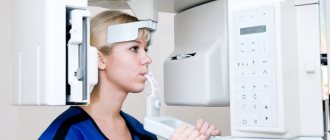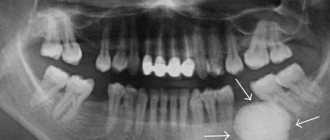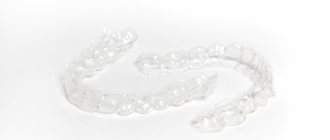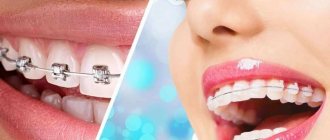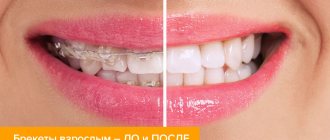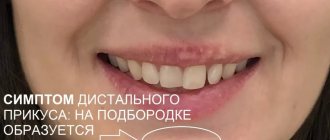To correct an abnormal bite, you can put braces on your teeth. Such orthodontic systems affect bone tissue, muscles and ligaments, and help slowly move teeth into the correct position. Many people are interested in the question: is it possible to put braces on one jaw? You will find the answer in this article.
In this article
- What are braces?
- Are braces placed on one jaw?
- Main indications for partial correction
- Orthodontic correction up to 12 years
- Braces for the lower jaw only for mild crowding
- Treatment for crowded upper anterior incisors
- Closing the gap between the front incisors
- Partial bracket system for preparation for prosthetics
- Absence of chewing teeth on the opposite jaw
- Should I install braces on one jaw or not?
What are braces?
A brace system is an orthodontic device that is installed on the teeth and helps them move in the desired direction. Structurally, this device consists of small plates (directly braces), which are glued to the dental crown at pre-calculated points, and a metal arch. This arc has shape memory and is an active element of the system. Fixed on the plates, it tries to regain its even position and thereby puts pressure on the teeth. As a result, their slow, gradual movement in the bone tissue occurs. Orthodontic treatment not only helps to correct the curvature of individual teeth in a row, it allows you to change the shape and position of the jaw, and restore facial symmetry.
It is preferable to begin orthodontic correction in childhood. But modern medical capabilities make it possible to carry it out even in adulthood and old age.
Most often, an orthodontic device is placed on two jaws at once. The dentist calculates in advance in which direction a particular tooth should move, how much it is necessary to expand the jaw or spread the dentition. Double-jaw treatment is comprehensive and allows you to solve global problems in occlusion correction. It usually takes from several months to several years.
Advantages of installation on both jaws at once
Advantages of corrective therapy:
- return of the aesthetics of the frontal zone;
- high efficiency, elimination of complex violations;
- permanent impact on the row without the need for tooth extraction or prosthetics;
- shortened treatment periods.
But the systems do not apply in the following situations:
- gingivitis, the presence of any inflammatory processes;
- allergic reactions to the materials used;
- the coronal part of the tooth in the lower row is too low (fastening the arch becomes difficult);
- crowding (with excessively severe pathology);
- serious TMJ dysfunction with organic tissue damage (preliminary treatment required).
Price
To calculate the cost of braces for two jaws in St. Petersburg, our clinic takes into account the following factors:
- the presence of diseases subject to preliminary treatment;
- cleaning teeth from stone;
- diagnostics and consultations with related specialists;
- materials, arc type;
- installation of the device and initial adjustment;
- regular visits for arch tightening;
- the use of special devices to consolidate the results obtained.
The initial visit to a doctor at our clinic is free. During the examination, the condition and severity are determined, and hardware research methods are prescribed. The full cost of braces for two jaws will include all of the listed parameters, but it must be taken into account that if the arch and individual elements break, paid repairs will be required. The price also increases when choosing lingual systems, transparent sapphire or ceramic models from leading brands.
About our clinic
Magenta Dental Clinic is a modern dental clinic offering services such as eliminating dental pathologies and restoring a beautiful, sparkling smile without pain and in the shortest possible time. Patients are provided with:
- modern methods of therapy;
- use of certified materials and equipment;
- full range of services, including diagnostics;
- control of treatment, guarantee of results;
- attentive attitude towards everyone, creation of comfortable conditions;
- affordable prices;
- free initial consultation with clinic doctors.
To make an appointment, leave a request on the website, indicating the coordinates for feedback. You can also call us by phone. For consultation or to get answers to your questions, send a request by email to [email protected] to consult with our doctors.
Are braces placed on one jaw?
Installing a brace system is one of the most common and effective methods for correcting an abnormal bite, improper closure of the teeth of the upper and lower jaw. Crooked teeth and abnormal jaw position not only spoil a person’s appearance, but also affect his health. Therefore, correcting the bite is important and necessary. But installing braces confuses many people.
Some are concerned about aesthetics, others are concerned about possible inconveniences when wearing the system, others simply want to save on orthodontic correction. And then the patient turns to the doctor with the following question: is it possible to install braces only on the upper jaw or only on the lower jaw.
As a rule, a person knows in advance which teeth he wants to change. And if they are located only on one jaw, then he expects that he will have a partial braces installed, only in the area of the curvature.
The doctor must make such a decision. It may seem to the patient that he has a problem only with the lower jaw, but the dentist sees during the examination that partial correction will not give an effective result. In this case, the orthodontist will insist on a complete correction. If you need a stable result of orthodontic treatment, we recommend listening to the professional opinion of an orthodontist.
How do the doctor and patient evaluate the result of the correction?
- The patient looks at the problem locally and only wants to straighten his teeth so that he can show off his smile without embarrassment. But long-term local defects in the dentition lead to the formation of a global problem - malocclusion.
- Therefore, the orthodontist sees his task not only in straightening the dentition, but also in achieving physiological closure of the teeth of the upper and lower jaw or maintaining a normal bite, which can be disrupted during the alignment of teeth only at the bottom or at the top.
Unfortunately, in the vast majority of cases, single-jaw braces do cause unwanted side effects or lead to unstable results in the long term. How will a patient who paid specifically for an aesthetic result, no matter how he imagines it, react to this? Of course, he won’t say thank you for his protruding teeth, and he certainly won’t remember that he saved 50% on the installation of turnkey braces.
Therefore, a decent doctor, when planning treatment, always assesses the risk of deterioration of the dental system and further progression of pathology, which is possible when correcting teeth only in the upper or only in the lower row. And in practice, there are cases when savings actually become possible.
Main indications for partial correction
In some cases, it is indeed possible to place braces on one jaw, and this approach will be effective. As a rule, these are situations where the teeth are only crooked at the top or bottom, but the bite is not broken and there is no facial asymmetry. Partial correction may be recommended for the following indications:
- one or two teeth are positioned incorrectly;
- slight crowding of teeth (lack of space - up to 3 mm);
- a gap between the front incisors in the absence of pathological closure of premolars and molars;
- correction of the position of teeth before installing dentures;
- the need to avoid sagging of the upper teeth when their antagonists (opposite units) in the lower jaw are absent.
Diagnostics will show how effective braces will be only on the upper jaw or, conversely, on the lower jaw. It should include a visual examination, x-rays, assessment of the condition of bone tissue and dental roots.
Let's consider cases when it is justified to place braces separately on the upper jaw and separately on the lower jaw.
Is it worth installing one system?
Installing braces on the upper jaw at an affordable price in Moscow is an advantageous offer that allows you to save money on bite treatment. But experts do not advise making the decision to correct only one jaw on your own. This method of eliminating bite defects is permissible only if the orthodontist confirms the absence of serious violations in the upper row and the need for correction of the lower jaw.
If the patient, despite the advice of a specialist, wants to install only one corrective system, then the doctor warns about the possible consequences. Most patients have problems closing their jaws after removing braces. Thus, even greater deformation occurs, requiring repeated, but complex treatment with a dual system.
Orthodontic correction up to 12 years
Braces are primarily used for children starting in their teens. This is due to the fact that by the age of 11-12 years the formation of the jaws is completed, and the primary bite is replaced by a permanent one. But often, an orthodontist discovers bite problems in a child at an earlier age. Installing partial braces helps solve some of them, as well as prepare teeth for further correction in adolescence.
The doctor can place an orthodontic device on one jaw or individual teeth in order to:
- create space for the eruption of permanent teeth;
- expand one of the jaws;
- close the gap between the front incisors (the so-called diastema);
- correct the incorrect position of one or more teeth that are bothering the child;
- preserve the space left after early removal of baby teeth, which neighboring ones are trying to occupy.
Thus, braces can be placed on one jaw at the age of 9-10 years to solve a specific orthodontic problem. In this case, in adolescence, further, already double-jaw, treatment will be required.
Let's sum it up
Are braces placed on one jaw? Partial installation of orthodontic systems is possible in the following cases:
- absence of serious problems with the patient’s bite: each tooth in the upper jaw is opposite the corresponding tooth in the lower jaw;
- absence of multiple curvatures of the row.
If the patient's bite is normal, the orthodontist will suggest partial installation of braces. If the patient needs bite correction, the entire jaw should not be corrected.
There are cases of single curvature of teeth in the upper or lower row - one or two. Then the orthodontist offers partial installation of a brace system as needed (if the patient’s bite is correctly formed).
Is it possible to put braces only on the upper jaw? Theoretically, yes. In practice, the issue comes down to the formation of a correct bite, which is of particular importance for the human gastrointestinal tract. Since both jaws take part in the formation of a correct bite, orthodontic structures should be installed on both rows of teeth.
The use of removable aligners to correct one or two uneven teeth is not always justified. Firstly, it is impossible to achieve perfect row evenness. Secondly, there is constant discomfort when wearing it, and it takes a long time to get used to it. Thirdly, mouthguards do not straighten the bite.
Which braces are the best? Only an orthodontist can determine this. For aesthetics, lingual constructions are better suited, although they are the most expensive. Also, lingual appliances provide ideal closure: they do not disturb the bite. However, such appliance designs are not suitable for short teeth.
Conclusion
Installing braces on only one jaw will not solve all problems with the correction of teeth and bite. Teeth are an integral part of the digestive system, on which human health depends. Therefore, the formation of a correct bite directly affects overall health. Accordingly, it is necessary to install orthodontic structures on both jaws.
Sources used:
- https://en.wikipedia.org/wiki/Dental_braces
- Khoroshilkina F.Ya. Orthodontics: a practical guide. - M.: Medical Information Agency LLC, 2006. - 544 p.
- Eckerman M.B. Orthodontic treatment: theory and practice. — “Medpress-inform”, 2010. — 160 p.
Braces for the lower jaw only for mild crowding
Crowding is the position of teeth when they are too close to each other. As a result, rotation, curvature, and “layering” of each other occur. If slight crowding is observed only on the lower front incisors, while the upper front incisors are positioned evenly and the lateral ones close correctly, in this case, braces are sometimes placed only on the lower jaw. An important condition for this method is that there must be enough space to move horizontally so that the teeth can take the correct position. This treatment method is chosen in cases where the lack of space for alignment is less than 3 mm. With this method, separation of the front incisors is almost always performed - that is, minor grinding of the contact surfaces, which allows you to free 0.25 mm from each surface and in total create those missing 1-3 mm for alignment in the dentition.
When to install braces on two jaws
Treatment with braces is prescribed after a preliminary diagnosis has been carried out, which confirms bite defects. Dentists recommend correcting the bite in adolescence, when the bone tissue is not yet very strong and can be corrected. In addition, signs of malocclusion appear after the replacement of milk teeth with all permanent ones.
Paired braces should be installed when dental defects are identified on one or both jaws:
- displacement of the tooth relative to the entire row;
- unnatural position of the tooth;
- gaps between the two front ones or between all units;
- incorrect position of the jaws to each other;
- asymmetry or defects in the facial profile;
- upcoming implantation;
- diseases of the jaw joint;
- consequences of jaw injury.
If you install braces, the price of a structure for 2 jaws will be significantly higher than for one system. But it should be borne in mind that if after removing some braces there are deviations in the relationship of the two jaws, then it will still be necessary to fix the systems on both dentitions. In this case, money and time will be spent on repeated full treatment.
Treatment for crowded upper anterior incisors
Braces on the upper jaw only can be placed if crowding is observed on the upper front incisors. The conditions are the same - the space deficit should be no more than 2-3 mm. In addition, treatment should not require expansion of the dentition. In this case, for orthodontic correction it is not necessary to involve the lower dentition.
If you provide space for uneven teeth by expanding the upper row, this will disrupt the closure. As a result, the teeth will “seek contact” with each other, the upper row will become narrow again, and in the long term the goal of orthodontic treatment will not be achieved. Therefore, if it is necessary to expand the upper row of teeth in order to correct crowding, a partial braces system cannot be used; a two-jaw apparatus will have to be installed. Braces can only be placed on the upper jaw if space for teeth is freed up using the separation method (their width is reduced by grinding the contact surfaces).
Contraindications
Installation of braces, regardless of the place of their attachment, is carried out only in the absence of concomitant dental diseases (pulpitis, caries, periodontal disease, etc.). Before the correction begins, the patient undergoes treatment and professional cleaning. These indications are relative limitations that can be eliminated before the main occlusion therapy is carried out.
Absolute contraindications to installing braces only on the upper dentition:
- severe form of bite pathology;
- deviation in the closure of the jaws or individual teeth (molars or canines);
- severe curvature of teeth;
- torsion with a distance between units greater than 1 mm;
- The gap between two adjacent teeth is more than 3 mm.
It is not recommended to put braces on people with mental illness, immunodeficiency, endocrine and cardiovascular systems, or oncology. In case of contraindications, A-Medic clinic specialists select another method for eliminating malocclusions.
Closing the gap between the front incisors
Braces can be placed on the lower jaw if there is a large gap (diastema) between the lower front incisors. In this case, several conditions must be met:
- the lateral teeth close together normally;
- there is an opportunity for a “joint to joint” closure of the front teeth of the upper and lower rows.
If these conditions are not met, it may be necessary to artificially increase the size of those teeth between which there is a gap. This is done using filling material. If the patient is not ready to fill healthy teeth in order to increase their size, then single-jaw treatment of diastema will not suit him, since the doctor will not be able to guarantee the stability of the result.
What are braces: design and its features
The bracket system is a non-removable orthodontic device for correcting permanent occlusion in children and adults. Braces are placed only after all the temporary teeth have been replaced and the second molars have grown in. Typically, bite correction is offered to adolescents aged 13-16 years. At this age, the maximum effectiveness of treatment is observed.
Bracket system design:
- Braces are permanent plates installed on each dental unit of the corrected row.
- An orthodontic arch is a wire made of a nickel-titanium alloy with a “memory effect”. It is bent along the line of the correct dentition and secured in the braces. The arc pulls on the teeth, gradually moving the crowns into the desired position.
- Additional accessories - rings, ligatures, springs and other elements to ensure optimal fixation and tension of the arc.
Vestibular braces are attached to the visible surface of the teeth, and lingual braces are attached to the inside of the dentition. Braces on the lower jaw are most often placed on vestibular braces, since their visibility is minimal, which means they have virtually no effect on the aesthetics of the smile.
Based on materials, braces are divided into:
- metal;
- ceramic;
- sapphire;
- plastic.
The best option for the lower jaw is metal braces. They will most quickly eliminate the existing dental anomaly, and at the same time will not cause inconvenience or complexes. You will also be pleased with the price of metal braces for the lower jaw - minimal when compared with other materials.
Partial bracket system for preparation for prosthetics
Sometimes braces are placed on only one jaw in preparation for prosthetics or in order to close empty spaces from extracted teeth. In the first case, braces help change the angle of the teeth to make room for an implant or bridge. In the second case, the brace system is used to move the posterior chewing tooth to the place of the previously removed one, thereby closing the empty gap and avoiding prosthetics. It is important to note that such treatment is usually complex and lengthy (tooth movement can take up to four years).
The orthodontist decides how appropriate it is to install a partial brace system for such indications in each specific case.
Correct placement of braces
Many patients resolutely refuse to install braces on both rows, explaining their refusal by the inappropriateness of straightening non-crooked teeth in the lower/upper row. However, not all so simple. The function of braces is not only to correct curvature, but also to straighten the bite.
The bite is responsible for the closure of the teeth of the lower and upper rows. The quality of grinding food in the oral cavity, and therefore the proper functioning of the entire digestive system, depends on the correct bite. However, patients in orthodontic clinics do not know about this. Moreover, malocclusion does not bother them.
What happens when orthodontic appliances are placed on only one jaw? Before the patient came to the clinic, the human jaw had been shaped for many years to a certain position of the rows, that is, the lower row with straight teeth was adjusted to the upper row with crooked ones. After straightening the upper row, the patient begins to notice that closure has become problematic.
Is it possible to install structures only on the upper jaw without negative consequences for the bite? Yes, it's possible. However, before making such a decision it is necessary:
- take an x-ray of the jaw;
- check the condition of bone tissue;
- check the condition of the root system of the teeth.
Only after a thorough examination of the jaw can a specific decision be made. If the orthodontist recommends braces on the upper jaw, this does not mean that the lower jaw will not be under control. The doctor must monitor the condition of the lower jaw during the process of adjusting the upper jaw, and take preventive measures in time. For example, retainers—removable orthodontic structures—can be used to correct the lower jaw. Retainers are worn at night or worn for an hour during the day.
Should I install braces on one jaw or not?
If the patient is concerned about the question of whether braces are placed on the lower jaw, then the answer will be positive. An orthodontic device can be installed not only on the lower or upper jaw, but also on individual teeth or areas of the dentition. But the main question is whether such treatment would be advisable. As a rule, installing a brace system on one jaw solves exclusively local dental problems. This process is more difficult to control and provides fewer treatment options. If contraindications are not provided, even a successful result will be short-lived, and the teeth will return to their previous position.
Thus, a dentist planning single-jaw orthodontic treatment must carefully assess the risks, take into account the many factors that will influence tooth movement and predict in advance the effectiveness and stability of the result.
If the doctor sees that solving the problem with a partial braces system will be problematic, he will recommend double-jaw treatment to the patient. Its advantages are that teeth can move in different planes without negative effects such as disruption of contacts between the upper and lower ones. Plus, such treatment is easier to predict and control, and it gives a more sustainable result.
Types of braces for the upper jaw
For minor dental defects in the upper jaw, treatment can be carried out with mouthguards, aligners or braces. The possibility of a more gentle effect on the dental composition is assessed by a specialist.
If the installation of braces is indicated, then after diagnostics and consultation, the orthodontist determines which design will be more effective and offers the patient several options for system models.
You can install ligature or non-ligature braces on the upper jaw. The difference between the models is that the first ones have locks or rubber bands on each plate to secure the arc, while the second ones do not. Orthodontists recommend a ligature-free system because it is more comfortable and does not require regular visits to a specialist to change the tension of the arch.
Clinic A-Medic offers a large selection of models from different manufacturers, made of various materials. The designs are made of metal, plastic, ceramic and sapphire. Considering that the upper teeth are visible when smiling, it is advisable to install ceramic or sapphire braces, as they look more aesthetically pleasing. But in case of complex pathologies, preference is given to a metal structure, which is considered more effective.
Lingual models deserve special attention. These are structures that are fixed on the inside of the teeth. Those placed outside are called vestibular. Lingual braces for the upper jaw can be made of metal, since they are completely invisible to others and are an ideal option for aesthetics. However, the price for lingual braces for the upper jaw is quite high, even if only one structure is fixed.
Frequently asked questions from patients
Doctors at the InWhite Medical clinic answered the most common questions that concern patients.
Under braces, teeth deteriorate, become loose, enamel wears off - is this true?
No, if you take good care of your braces and teeth during treatment, the enamel and the teeth themselves will not deteriorate. A qualified doctor will make sure that the teeth do not wobble, but move smoothly to the correct position.
How to pass a metal detector with metal braces?
Braces are made of non-magnetic metal, or more precisely, of a special medical alloy. Therefore, you can do MRIs with them, undergo inspections and walk in the winter.
Is it possible to put a brace on one lower tooth that is crooked?
No, the locks themselves do not straighten anything, the arc straightens it. And to work, it needs support and a complex system.
How much does it cost to get braces on the lower jaw?
The cost of braces for the lower jaw depends on the material of the structure. Metal braces are cheaper than ceramic braces. The most expensive are sapphire and lingual systems.
If you want to get braces only on the lower jaw, contact the InWhite Medical clinic. We will conduct all the necessary research and painlessly install braces on one jaw, if there is an indication for it. If not, we will select the most inconspicuous and miniature system that will decorate your smile.
Installation process
The procedure for installing orthodontic structures is quite labor-intensive and requires certain work experience. First of all, a special mouth opener is placed in the oral cavity, thanks to which the view of the jaw becomes much better. After this, the doctor can begin cleansing the oral cavity, polishing and strengthening the enamel. Next, the master installs the staples, using a powerful adhesive for this.
At the initial consultation, the orthodontist will definitely warn you about which braces can be used to achieve the desired result in the shortest possible time. It is also important to know that the fixation of staples itself without the use of ligatures is much faster compared to the installation of lingual ligature analogues.
Braces are always attached to the upper jaw first, and then to the lower jaw. The type of system does not have any influence on this fact. After the brackets are secured, the power arc is installed. It is inserted into small holes in the locks and held in place with rubber bands (if a ligature system is used).



